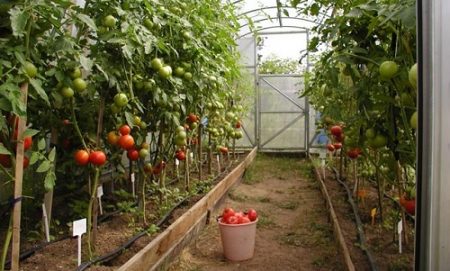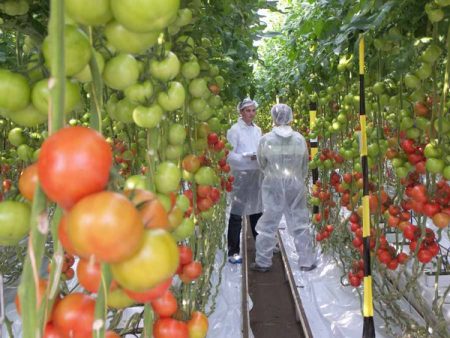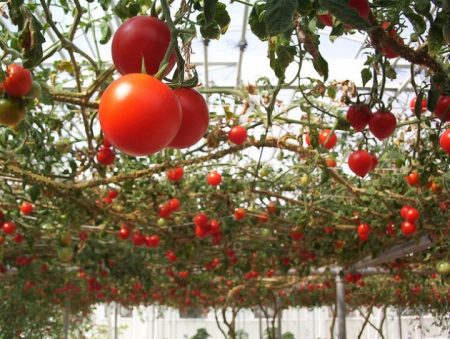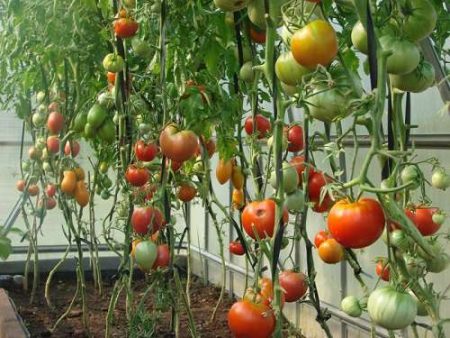 Probably, there is not a single summer cottage on which tomatoes would not be grown. Juicy tomatoes have long won the hearts of many gardeners, because what could be better than natural, ripe vegetables directly from the garden, grown by your own hands?
Probably, there is not a single summer cottage on which tomatoes would not be grown. Juicy tomatoes have long won the hearts of many gardeners, because what could be better than natural, ripe vegetables directly from the garden, grown by your own hands?
There are several options for growing tomatoes. For example, if a culture grows in a greenhouse made of polycarbonate, then here, when growing, it is necessary to observe some nuances. Of course, the differences are not significant, but they are worth paying attention to. What tomatoes to plant in a polycarbonate greenhouse and how to grow them. How is planting tomatoes according to the method of I. M. Maslov.
Stage One: Greenhouse Preparation
Planting tomatoes in a polycarbonate greenhouse is very convenient and practical. But, in this matter, it is important to prepare the greenhouse for a long time before the very moment of planting. Everything should already be prepared for spring. Indeed, with the first rays of the sun, the greenhouse is filled with heat, keeping it for future tomatoes. The greenhouse should be placed in a place where the shadow does not fall, so that it is always well lit.
Tomatoes are very whimsical to the light, therefore, even a small shadow can reduce the yield of the plant. Still speaking about the preparation of a polycarbonate greenhouse, it must be taken into account that there are windows on the structure, because the culture needs to be aired during the flowering period.
What tomatoes are suitable
And now, when the construction is ready, you need to decide which tomatoes to plant in a polycarbonate greenhouse (video).
What tomatoes plant in a polycarbonate greenhouse? It is also important to consider that the varieties are with unlimited growth. Their difference lies in the fact that they bear fruit early, and inflorescences are formed through one or two leaves. This position allows you to form two stalks, and 14 brushes can form on one bush, which is twice as much as in the case of limited growth.
Also, such varieties that are planted in a polycarbonate greenhouse are precocious. At the end of the last summer month, all the fruits on the bush are already ripening. So, what tomatoes to plant in a polycarbonate greenhouse? Hybrid varieties, unlimited growth, are suitable for the suburbs.
How to prepare seeds
In order to get strong seedlings, tomato seeds must be properly prepared. So that they are not attacked by diseases, they must be processed. All seeds are placed in a tissue bag, in this form they are lowered for 20 minutes in a potassium permanganate solution. For the solution, you need to take one gram of manganese in one glass of water.

After the bags with seeds are treated with a solution, they must be washed under a stream of clean water. Then, again dip into the following solution: a teaspoon of nitrophoska is dissolved in a liter of water. This time, the seeds in the solution are left for half a day and put in a warm place.
Next, this bag should be pulled out of the solution, and without rinsing, put in a deep plate with water, leaving them for 24 hours.
After all these procedures, the seeds should be hardened. To do this, they must be sent to the refrigerator, where they must stay for at least two days. It is important during this time to prevent drying of the seeds. And only after that the seeds can finally be sent to the soil, and immediately.Such seeds are sown in moist soil for tomato seedlings.

Planting seeds for seedlings is necessary in low containers, about 5-7 centimeters will be enough. Seeds are planted at a distance of 1.5 centimeters from each other, and buried about 2 centimeters in depth. Tanks with seedlings are placed in a warm, well-lit place. To make the first shoots appear faster, five days after planting, the containers must be covered with polyethylene.
What tomatoes to plant in a polycarbonate greenhouse, different varieties are planted in different containers, so as not to confuse. And the most suitable time for this is February.
Rules for growing seedlings
Most often, seedlings for growing in a polycarbonate greenhouse grow in length by no more than 40 centimeters. The seedlings form a strong root system and a dense stem. Before planting in open ground, it must be loosened, since tomatoes prefer a loose earth. Also, the soil should have a good drainage system, since tomatoes do not like waterlogged soil.
By the end of spring and early summer, you can transplant seedlings into a greenhouse. At the same time, it is important to ensure that the temperature of the soil at a depth of 20 centimeters is not lower than 13 degrees. If the temperature is lower, then the roots of the plant simply can not absorb moisture and the nutrients necessary for growth.
Important! As soon as the seedlings are planted in the greenhouse, you immediately need to make small dimples for fertilizer on the top layer of the soil.

In order for the tomatoes to grow fully in the polycarbonate greenhouse, the first two weeks they do not need to be watered. Before the formation of the first fruits, the plant is watered sparingly to prevent overmoistening of the soil, which, recall, the tomatoes do not tolerate.
But in the period of tying up, the irrigation procedure must be approached responsibly. If there is not enough moisture, apical rot will develop, and if waterlogging is allowed, then the roots may die out. The main thing here is to observe the golden mean. Tomatoes are watered only at the root, water should get into the soil no deeper than 15 centimeters. It is impossible that droplets of water fall on the plant itself, this can cause infections, and, as a result, diseases. What kind of vegetables plant tomatoes in the greenhouse.
Knowing which tomatoes to plant in a polycarbonate greenhouse, and how to grow seedlings from seeds, you can get a rich harvest in the shortest possible time. The advantages of this method of growing tomatoes is that it is budget and fast. Tomatoes of hybrid varieties grown in a polycarbonate greenhouse are very tasty and juicy. The main thing in this matter is not to ignore all the tips for caring for the plant and the procedures for preparing the greenhouse and seeds.
Good luck in the garden and a rich harvest!




 Low-growing tomatoes, without pinching: 5 of the most delicious varieties
Low-growing tomatoes, without pinching: 5 of the most delicious varieties Why tomato seedlings grow poorly
Why tomato seedlings grow poorly We grow a tomato in a shell
We grow a tomato in a shell Growing tomatoes without watering according to the method of Kazarin
Growing tomatoes without watering according to the method of Kazarin